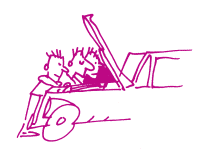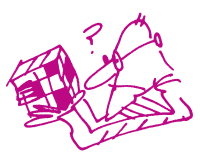| Featured Article
| ||||||||||||||||||||||
|
Problem-Based Learning: An Introduction
James Rhem, Executive EditorThere must be something compellingly effective about problem-based learning, given the level of faculty interest in it all through higher education. After all, no one thinks it's easier or takes less time. And, as with almost every other change in teaching, students resist it, at least at first. Why, then, have medical and professional schools embraced it so enthusiastically? Why has the Pew Charitable Trusts given over $600,000 to the University of Delaware and a similar grant to Samford University in Alabama to investigate restructuring traditional instruction along problem-based lines?
What It DoesThe list of reasons includes the fact that problem-based learning (PBL) ends up orienting students toward meaning-making over fact-collecting. They learn via contextualized problem sets and situations. Because of that, and all that goes with that, namely the dynamics of group work and independent investigation, they achieve higher levels of comprehension, develop more learning and knowledge-forming skills and more social skills as well. This approach to teaching brings prior knowledge into play more rapidly and ends up fostering learning that adapts to new situations and related domains as quickly and with the same joyous magic as a stone skipped over a body of water.
What It IsIn some ways what PBL is seems self-evident: it's learning that results from working with problems. Official descriptions generally describe it as "an instructional strategy in which students confront contextualized, ill-structured problems and strive to find meaningful solutions." But where does it fit compared with all the other "learnings" faculty
hear about--"cooperative learning," "collaborative learning," and "active
learning"? The proliferation of "learnings" and their attendant partisan
camps invites the reawakening of long-standing faculty prejudice against
educational fads and "methods." Even so, interest in PBL grows because not
only does research show a higher quality of learning (though not a greater
amount if "amount" equates with the number of facts), but problem-based
learning simply feels right intuitively. It seems to reflect the way the
mind actually works, not a set of parlor-game procedures for manipulating
students into learning. Thus, seen as a reification of cognitive processes, in a problem-based approach teaching and learning at last seem like two sides of one coin, not something done by one group to another, and faculty instinctively feel the intellectual commonalities between research and teaching, between their own intellectual lives and their role in the intellectual lives of students. John Cavanaugh, vice-provost for Academic Programs and Planning at Delaware and principle investigator on the Pew grant, sorts out the place of PBL among the "learnings" this way: "Imagine a family tree: Active Learning would be at the top. Cooperative/Collaborative would be a subset of that, and I see PBL as a subset of Coop/Collab based on cases. All forms of group work don't center on cases; problem-based groups do."
Historical OriginsThe modern history of problem-based learning begins in the early 1970s at the medical school at McMaster University in Canada. Its intellectual history is far older. Thomas Corts, president of Samford University, sees PBL as "a newly recovered style of learning" In his view, it embraces the question-and-answer dialectical approach associated with Socrates as well as the Hegelian thesis-antithesis-synthesis dialectic. As John Cavanaugh puts it: "It's like discovery-based learning in the 1960s. We knew about it; we didn't do it. Dewey talked about it when he talked about 'engagement.' Dewey had it right on the abstract level. We do the details better now, that's all, and that's because of advances in cognitive science and in technology." Until recently the PBL approach has flourished mainly in medical and professional schools. Slowly the sciences in general have begun taking it up, and even more slowly, the humanities. PBL does not have a store of transferable techniques or methods like Cooperative Learning, no "jigsaw," no "think-pair-share" or that sort of thing. Opinions vary on whether PBL should be implemented for entire courses or whether it can be used merely to teach certain parts of courses. In general, advocates accept faculty easing into the approach piecemeal, but favor course-long continuity.
Roles And ProceduresUsually, a class is divided into groups of approximately five students each. The groups' membership generally remains constant throughout the term. At the purest level, the groups define the "learning issues" they believe each new problem presents and decide how to divide their labors to resolve them. Thus, aggressive PBL implementation requires ample library resources. Likewise, large class situations require an adequate number of tutors to act as support and facilitators to the groups. Indeed, this facilitator role poses the strongest challenge for some faculty. Knowing how to work with groups (as well as how to train groups how to work with each other) is not something most faculty presume expertise in. Knowing how to guide without seeming to be coyly hiding the answer is no mean feat. And it's not an easy matter posing authentic problems, problems with a certain open-endedness about them, either.
When it comes to creating problems, John Cavanaugh says: "One place to start is to take your exams and work backwards. Take those word problems and essay questions and make cases out of them." Loreta Ulmer, who teaches psychology at Delaware Technical and Community College, says it's hard work revamping a course into problems, "but after you've done it, the whole course becomes so exciting, you'd never go back." Ulmer uses a modified form of PBL, combining mini-lectures on some days with in-class, small group work on problem sets later in the week. She sees in-class work, with all the resources provided, as a necessity for students at her two-year school. Like most faculty, in the beginning she worried about coverage and struggled with the tutor's role, wanting to keep the students on the "right" path in their discussions. "I had trouble with that at first," she admits, "but the more I've done it, the more I've come to trust students to figure things out. Giving up control is hard, but if you let the learning happen, it will." At the start, Ulmer worried that students weren't getting enough exposure to different theoretical perspectives. When her PBL students turned up in her advanced class in Human Development, she found that while they might not be able to spout names and dates, they had the concepts. "And that was better, really," she says. Says Ulmer: "This approach gives students immediate feedback. It keeps a constant flow going between teacher and student, and you can't put a price tag on that." Chandra Reedy, who teaches art history at the University of Delaware, uses PBL in just the same way, not because of limits on library and other resources, but because she's not quite ready to use PBL for everything. For her the problems move students to apply and integrate material and thus to actually learn it in ways they otherwise wouldn't. "I was teaching courses with lots of information and students weren't remembering three-fourths of it and I was discouraged," she says. Now, it's different: "When they apply it--working in a group, figuring it out for themselves--they remember it." Beyond agreement on a basic approach, faculty understanding and implementation of PBL varies widely. Uniformly, however, practitioners agree on several things: they've seldom felt as energized about their teaching and seldom seen their students so motivated and involved. "I would have a hard time telling you of a single faculty member who's tried PBL and then gone back to traditional lecture," says Barbara Duch, associate director of Delaware's Mathematics and Science Education Resource Center. Duch, a physics professor and a passionate advocate of PBL, recalls: "I lectured for years, but there is something so powerful in PBL. You're never quite sure what's going to happen, but attendance is 100%, the students are motivated, working on problems. It has restored the intellectual excitement for faculty who said they had been burned out."
So Long, TontoSo why now? If problem solving, "engagement," applying, active questioning have been recognized as the keys to motivation and effective education for generations, why has the approach been "newly recovered"? For at least two main reasons. David Chapman, associate dean of Arts and Science at Samford University, points to the "information explosion." That, he says, has made "the coverage model in traditional survey courses more and more difficult to defend." Barbara Duch puts it plainly: "Faculty have to make hard decisions and get to the essentials." "The Lone Ranger is gone," says John Cavanaugh. That's the second reason PBL's time has come. "The way the world works now, it's about working together." What students learn about collaboration, different approaches to a problem, cooperation and responsibility, makes their learning in PBL courses multisided, richer, and, in that way, deeper.

PBL ResourcesAdditional reading on Problem-based Learning begins with two small books:
A number of content-rich Web sites offer information on problem-based learning. The University of Delaware's site (http://www.udel.edu/pbl/) contains articles about problem-based learning by faculty in various disciplines who have implemented it in their classes on the Delaware campus, as well as articles on problem-based learning written by Barbara Duch and others who've become practical experts in the area. The site also includes a comprehensive listing of links to other PBL sites. A well laid-out, eight-page tutorial on the topic resides at http://edweb.sdsu.edu/clrit/learningtree/PBL/WhatisPBL.html The tutorial covers such matters as Barriers, Overcoming Barriers and Implementing PBL, Assessment of Problem-Based Learning, and Creating an Appropriate Problem. Three listserves now exist dedicated to problem-based
learning--PBL-LIST, based in Australia, IMSACPBL-L, devoted to K-12 uses,
based in Illinois, and UD-PBL-UNDERGRAD, focusing on undergraduate
instruction, out of Delaware. Here's information on subscribing to these
lists. In doing so, remember to disable your signature file, leave the
subject line of your message blank and in the body of your message write:
"subscribe PBL-LIST (owned by the Department of Civil Engineering, University of
Monash, Australia). Subscription address: majordomo@vifp.monash.edu.au.
Additional information at: http://www-civil.eng.monash.edu.au/affil/pbl-list/pbl-list.htm.
IMSACPBL-L (owned by the Illinois Mathemathics and Science Academy).
Subscription address: majordomo@imsa.edu. Additional
information at: http://www.imsa.edu/team/cpbl/web/listserv.html.
UD-PBL-UNDERGRAD (owned by the University of Delaware). Subscription
address: majordomo@udel.edu.
Additional information at: http://www.udel.edu/pbl/ud-pbl-undergrad.html.
| |||||||||||||||||||||

[Home] [Site Map] [Search] [Subscribe] [About NTLF] [Current Issue] [Previous Issues] [Discussion Forum] [Special Features] [Library] [Sweepstakes]
Web Weaving™ By InfoStreet, Inc. |

